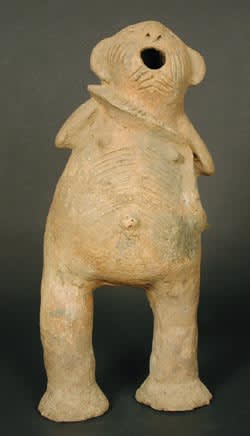African Art / Dakakari Terracotta Sculpture, 18th Century CE - 20th Century CE
Terracotta
8 x 18
PF.5542 (LSO)
Further images
This schematic rendering of a human figure was made by the Dakakari people. It is a highly unusual representation in terms of expression and also asymmetry. The body is globular...
This schematic rendering of a human figure was made by the Dakakari people. It is a highly unusual representation in terms of expression and also asymmetry. The body is globular and corpulent, with very long, trunk-like legs and flat, round feet. The arms are nugatory, resembling flaps or small wings more than arms. The figure is leaning to its left side, which is exaggerated by the hatched necklace or similar which circles the neck and slants sharply to the left side and under the arm. This may be intended to portray a rope. The face is typically Dakakari in its deconstruction, a round, hollow head with low relief eyes and nose, and the mouth rendered as a round hole that might have meant that the piece could have been used to contain and pour liquids. The face and the abdomen are scarred with herringbone patterns; details are otherwise absent, except for a marked navel and breasts or nipples. The clay is pale in colour, and very hard-fired. The position of the feet indicates that it may once have been attached to a spherical vessel; the reason for this is explained below.
The Dakakiri people of NW Nigeria are a little-studied group that are primarily known for their unusual funerary traditions. The standard practice was to bury individuals with a range of plain pottery for their use in the afterlife. However, it is the burials of the higher status individuals from the tribe – including their chiefs and their retinue – that give rise to the production of the Dakakiri’s major contribution to the corpus of African art history. Prestige individuals are buried in stone-lined shaft tombs; the sealed tops of these tombs are ringed around with stone walls to create a small enclosure.
Skilled potters are then commissioned to create sculptural vessels, with plain, spherical bases that are buried into the underlying soil, and with anthropomorphic or zoomorphic superstructures that commemorate the deceased. The deceased are venerated annually by pouring libations of maize flour or beer over the pots. The trade was usually kept within families; experience was all-important – the most prestigious potters were often post-menopausal women. Every person who dies in an elite family has another piece – or pieces – dedicated to them and placed within the superstructure over time, these collections can build up considerably, marking the development of the family throughout generations.
This may have represented the favourite wife of the deceased, or perhaps was a direct representation of the interred person. It is likely to have performed some ritual function of even just affectionate gesture for the dead. This is a rare and important piece of African art.
The Dakakiri people of NW Nigeria are a little-studied group that are primarily known for their unusual funerary traditions. The standard practice was to bury individuals with a range of plain pottery for their use in the afterlife. However, it is the burials of the higher status individuals from the tribe – including their chiefs and their retinue – that give rise to the production of the Dakakiri’s major contribution to the corpus of African art history. Prestige individuals are buried in stone-lined shaft tombs; the sealed tops of these tombs are ringed around with stone walls to create a small enclosure.
Skilled potters are then commissioned to create sculptural vessels, with plain, spherical bases that are buried into the underlying soil, and with anthropomorphic or zoomorphic superstructures that commemorate the deceased. The deceased are venerated annually by pouring libations of maize flour or beer over the pots. The trade was usually kept within families; experience was all-important – the most prestigious potters were often post-menopausal women. Every person who dies in an elite family has another piece – or pieces – dedicated to them and placed within the superstructure over time, these collections can build up considerably, marking the development of the family throughout generations.
This may have represented the favourite wife of the deceased, or perhaps was a direct representation of the interred person. It is likely to have performed some ritual function of even just affectionate gesture for the dead. This is a rare and important piece of African art.









